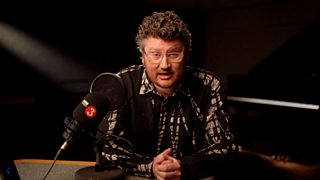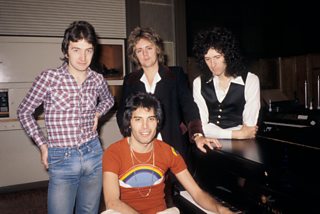Music Intros that Make You Say 'Wow'
A new Radio 3 programme, The Listening Service, invites us to ‘Rethink Music’. Presenter Tom Service begins at the beginning…
Beginnings count. If composers and song-writers can’t get our attention and hold it through the first few seconds of their track, their symphony, or even their opera, we’re unlikely to want to stick with them all the way through to the end of the album, the final movement of the symphony, or the dénouement of the operatic story. So here’s a ten-fold set of starters that reveal different ways to engage our attention - and, hopefully, to keep it! – whether they begin with an explosion, a mystery, or an enigma…
1. Explosions
Beethoven: Eroica Symphony
Music that says: Listen to This!, with a hammer-blow of two huge chords from the full orchestra.

It’s a hook that does what it says on the tin, latching on to our ears and never letting go.
It’s a command to Beethoven's early 19th century audiences to wake up out of their somnolent expectations that this symphony might be just another idle aristocratic entertainment. Instead, the Eroica Symphony is a wild existential ride, propelled by those first two chords.
Bach: Christmas Oratorio
A cosmically joyful and optimistic opening to Bach’s celebration of the Christmas story. There's an organ chord, an irresistible rhythmic lick in the timpani, and the rest of the instruments of the orchestra rush to join in with a skirl of woodwind melodies and a scintillating flourish for the brass and the strings, all setting the scene for the choir's noisy, triumphant tumult.
Anna Meredith: Nautilus
Anna’s Meredith’s Nautilus starts with a blaring brassy fanfare, but what begins like a straightforward call to attention becomes something much richer, denser, and stranger, as these brassy rhythms are layered on top of each other, and a monstrous bass line threatens to take over the whole texture. And you can hear Anna tell us how she plays with our expectations as listeners in the first episode of The Listening Service.
Eric Clapton/Derek and the Dominos: Layla
Layla? An explosion? Well: it’s one of the most famous hooks in rock history, and as Neil Brand tells us in our Beginnings programme, it’s one of the most brilliantly effective - and rhythmically inventive, too. It’s a hook that does what it says on the tin, latching on to our ears and never letting go.

Explosive musical openings
Attention grabbing introductions from Beethoven, Bach, Anna Meredith and Eric Clapton.
2. Mysteries
Beethoven’s Ninth Symphony
The first audiences for Beethoven’s Ninth Symphony must have wondered if the orchestra had finished tuning, or whether the symphony had really begun. Beethoven dares to start this biggest symphony in musical history in 1824 - and the first with a choir - without any of the conventions that previous symphonies, including his own, had established. Not only does it start quietly, with a primeval pianissimo, there’s also no real theme or melody. It’s a signal of the gigantic ambition of this piece, because out of this musical Nothing, Beethoven goes on to create one of the most shattering and all-encompassing musical experiences of all time.

Wagner’s Ring Cycle
Mind you, Wagner would have something to say about that: at the start of his four-opera, fifteen-hour Ring Cycle, Wagner goes even further than Beethoven. He built his own theatre for the performance of this piece, and when the first audiences gathered in the auditorium at Bayreuth in Germany in 1876, they couldn’t even see the orchestra, because Wagner’s design concealed the musicians underneath the stage. In this disconcerting sensorium, they would have heard an astonishing sound emerge out of the gloom: a fundamental note and a single chord, starting in the lowest sonic reaches of the double-basses, horns, and bassoons, and soon overflowing the whole orchestra. It's an overwhelming sounding image of the River Rhine, the mythic location for the Ring Cycle’s apocalyptic story.
Queen: Bohemian Rhapsody
It starts like a weird madrigal, but turns into one of the most surreal - and most surreally famous - poperatic epics ever written. Queen's musical range and ambition is signalled by this opening, which sets the scene for the strange and murderous story they’re about to tell. I know it’s hard, but if you listen to this song as if you’ve never heard it before, you’ll realise that this beguiling close vocal harmony in the intro gives no clue whatsoever about the drama to come. Queen are playing with us, in other words - and we love it!
3. Enigmas
Mozart: The Marriage of Figaro
Another of those openings whose experimentalism is obscured by how famous the piece has become. But the Overture to The Marriage of Figaro would have caught its first listeners completely by surprise. Yes, it’s another take on the quiet-where-it-should-be-loud idea, but Mozart does something even more risky at the start of his opera as the first few bars have an irregular, unpredictable shape. It’s music that sounds breathless - it’s twitchy, full of a nervous, rebellious energy that can’t quite be contained. In that sense, it's a perfect distillation of the radical energy that’s about to be unleashed on the stage, as the servants in the story outwit their masters.
This extraordinary transcendence of personal confession and fearless political and social commentary begins in a completely unexpected way.
Varèse: Tuning Up
Varèse’s piece does what Beethoven’s threatened to, because he actually elides the orchestra’s ritual tuning of their instruments - usually done before the performance starts - with the opening of his piece, so we literally don’t know when it has begun. When you see it in a concert hall, this is a brilliant moment, a musical coup de thêatre that's guaranteed to jolt audiences out of their preconceptions that orchestral concerts always have to start from a reverential silence.
Beyoncé: Pray That You’ll Catch Me, from Lemonade
Songwriters and producers never stop finding new ways to start an album, or a whole creative project. Beyoncé’s Lemonade is a case in point. This extraordinary transcendence of personal confession and fearless political and social commentary begins in a completely unexpected way. It’s the opposite of a big statement: instead, Beyoncé starts the first track with an intro that’s designed to make us question where we are, musically and expressively. There’s a chopped-up synth sound, a vocal sigh, and a strange, halting melody with a chorus of weird multi-tracked voices. Like all the best openings, this one makes us sit up and pay attention, and leads us into a distinctive musical world that belongs especially to this song, this album, this experience.
More from The Listening Service
-
![]()
Is this the Greatest Rock Opening Ever?
An explosive start to Eric Clapton's Layla
-
![]()
Anna Meredith: ‘Get something down'
Anna Meredith describes her process for starting a piece of music.
-
![]()
The Listening Service Playlist
Hear all of the music featured in the programme each week with BBC Music.
-
![]()
Peaky Blinders - who is that bell tolling for?
Rethink music - Watch Tom Service dissect Red Right Hand by Nick Cave and the Bad Seeds.




